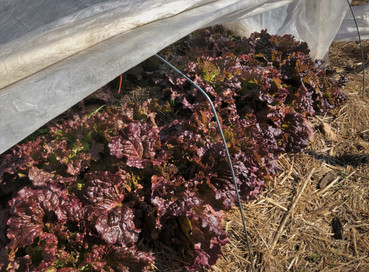November 11 - 30
- Rosa
- Dec 1, 2019
- 5 min read
Fall Feast
The last weeks of November were carried in on cold winds. Trees shed the last of their leaves and hunkered down to slumber through the frosts. The land now feels quiet and sleepy.
Despite this, the chickens are as vivacious as ever. We collected gracious donations of old decoration pumpkins to use as chicken treats. We smash one open into the chicken yards, and the hens flock to eat the gooey insides and the seeds. After feasting, they spend a few days stripping the pumpkin down to the hard outer rind. Then we smash the next one, and they delightedly repeat the process.
Little Green Things
Delicate green things still flourish in the safety of row covers and grow lights. Our lettuces are as productive as ever, especially our red bibb lettuce. Lettuces may not be frost hardy but they despise the heat almost as much as the ice. Their thin, watery leaves don't handle water stress very well, so the damp, cold seasons are their favorites. We regularly harvest the outer leaves to keep the plants producing.
On our growing tables, the next generation of flowers is sprouting. Unfortunately, many of the seeds we sowed in the early fall never germinated. Though it was a sad loss, we have time to learn from what went wrong. The seeds we are nurturing now will fill in the blanks and (fingers double-crossed) provide us with a robust, early spring crop.
Seed collecting is still petering onward, as Lilly and I process the dried pods from summer plants. Lilly shucked the okra, now crunchy and stiff. I pulled the wispy floof of seeds from the milkweed pods and compressed it into a jar. Milkweed is notoriously difficult to start from seed, but hopefully among the hundreds, a few will come to bloom.
Clearing and Comfrey
We cut down the hibiscus, which took our strongest pair of pruning shears. The plants build very impressive stems in the single season they live. The stems are bright red, which is beautiful, and covered in prickly hairs, which is unfortunate. We left the bases in the ground to decompose until we clear them from the bed.
Comfrey, unlike hibiscus, is a cold-hardy perennial. Our comfrey plants show very little frost damage at all; in fact they were doing well enough to divide. Lilly dug up several of our strongest plants and cut the root balls into portions. Comfrey is a profoundly tough plant: just a sliver of root material can turn into a whole, flourishing plant in less than a season.
We planted the pieces of comfrey in a line along the outside of the garden. The mature plants will act as weed suppressants, their plume of broad leaves shading out the grasses and other invaders. Several times a year we'll be able to harvest the leaves and use them to make "comfrey tea", which is an excellent liquid fertilizer. For now, though, the divided root pieces each have just a leaf or two protruding from the ground, growing slowly as they wait for spring.
Constructing Compost
At long last, we built a proper compost system! The system is composed of four bays, each around 10 feet long and 6 feet deep. We constructed it from left-over materials, including particle board, metal siding, and fencing poles. It took a two days to plan and complete, and now we have the capacity to turn all of our green waste, food waste, leaves, and old plants into rich new soil.
We started by planning and measuring based on the materials we had. Lillian researched methods of composting and decided four bays would work for our intake and output. We sunk the green fencing poles at regular increments along the back of the bays. Then we stretch chicken wire along them and secured it with zip-ties.
Next, we affixed metal panels on the outside of chicken wire and poles. We drilled holes through the panels and secured them to the poles with wire. We secured another line of panels above the bottom row, layering it slightly so that it was strong and secure. On the other side, we sunk more fence poles where we wanted the sides of the bays to be. Then we slotted particle boards between them.
We finished constructing the bays in the final moments of the evening, so it wasn't until the next morning that we got to put them to work. We started with a base of leaves and very old plant material. Then we layered on recently mowed grass from our field. Then we added food waste, which we've been composting in its own pile for a few months.
Next, we collected all of the piles of pulled summer plants from around the gardens and put them into a single massive heap. Then, we mowed them over with the tractor.
The old plant stems were ridged and dry, composed of complex carbohydrates like cellulose. It's a tall task to ask microbes to break them down, so the mowing gave them some help. It broke the material into smaller pieces, like chewing food before digestion.
We layered on the mowed material, then more grass, then more plant material, then more food waste. Layering like this helps the compost in several ways, but the main focus is to balance the carbon and nitrogen content. Nitrogen is a very limited nutrient in soil systems, and one that plants absolutely require. Decomposition microbes need it too. But the primary element in plant and food waste is carbon. Carbon is important to soil structure and plant health, but it is not limited in a compost system like ours.
So, as we layer our compost, we pay attention to the proportion of nitrogen in each material. Dry stems contain nearly negligible amounts of nitrogen for each unit of carbon. Leaves contain much more, as does hay. Green grass cuttings and food waste are good sources of nitrogen, and things like coffee grounds are excellent.
We finished off the pile with a tiny scoop of living soil, in order to introduce good microbes, and a layer of leaves to keep it damp. This pile will decompose for several months, and then, we'll rotate it to the next bay in order to aerate it. After that, it will sit for a few more months. Once it's soil, we'll leave it in the final bay. By that time, more piles will be building up in the first two bays.
Soil building takes a rather long time, but I'm very excited to finally have a proper place to put all of our old plants and food scraps. It's gratifying to dump some coffee grounds, old bread, and up-rooted zinnias onto a pile and know that one day it will nourish the garden.

























































Comments